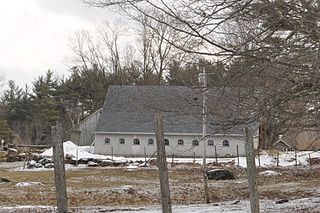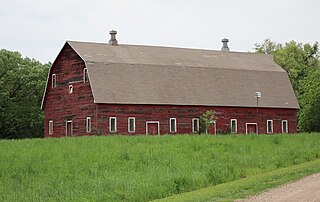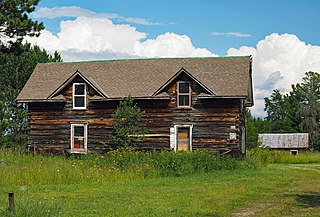Westphalia is a small unincorporated community in Falls County, Texas, United States located 35 mi (56 km) south of Waco on State Highway 320. Westphalia has a strong German and Catholic background. The Church of the Visitation was, until recently, the largest wooden church west of the Mississippi River. Westphalia is mainly noted for its historic church and convents, but also for its meat market and for its annual church picnic, which is one of the largest in the area. Westphalia is also known for the Westphalia Waltz.
The Namur Historic District, also known as the Namur Belgian-American District, is a historic district in southwestern Door County, Wisconsin. The district includes the community of Namur and a rural landscape extending 3 miles (4.8 km) to its north. It contains one of the nation's highest concentrations of immigrant Belgian and Belgian-American culture, land use, and architecture. It was declared a National Historic Landmark in 1990.
The Swedish American Farmsteads of Porter County, Indiana are representative of the numerous rural communities settled by a significant ethnic population. They influenced the religious community and social community. This collection is the most complete early 20th century complex within the Swedish cultural landscape of Baileytown and has retained a great deal of integrity.

The Hanka Homestead now known as the Hanka Homestead Finnish Museum is a group of eight buildings on a 40-acre (16 ha) homestead. It is located three miles (4.8 km) west of U.S. Highway 41, off Tower Road, near Pelkie, Michigan, in the United States. The homestead was added to the National Register of Historic Places in 1984.

The Alex Seitaniemi Housebarn is a rare surviving example of a log housebarn constructed by Finnish Americans, located in Waasa Township, Minnesota, United States. It was built in two stages from about 1907 to about 1913. The housebarn was listed on the National Register of Historic Places in 1990 for its national significance in the themes of architecture and European ethnic heritage. It was nominated for being an example of a rare building type and for embodying the settlement and traditional log architecture of rural St. Louis County's Finnish American farmers.
Smithson–McCall Farm is a 256.3-acre (103.7 ha) historic district in Bethesda, Tennessee. The farm was listed under the National Register of Historic Places in 2007. The listing claims that the property "documents the impact of the progressive agricultural movement of the early twentieth century on the operations and landscape of a middle-class family farm," and includes an "architecturally significant group of buildings and structures, placed within an agricultural landscape of high integrity...that represents a good example of farmstead architecture in Middle Tennessee and that reflects the impact of the Progressive Farm movement of the early twentieth century".

The Louden Machinery Company was an American engineering, manufacturing and design company based in Fairfield, Iowa. Founded by William Louden, the company in its early years manufactured and sold the patented hay carrier that he invented in 1867. The company later expanded into a wide variety of farm equipment and, in 1906, began an Architecture Department that reportedly designed more than 25,000 barns from 1906 to 1939. During World War I, Louden's monorail equipment carrier began to be applied to industrial and military applications. By the 1920s, much of the company's revenues were derived from industrial applications of its monorail equipment carriers.

The Frost Farm is a historic farmstead on Korpi Road in Dublin, New Hampshire. It includes a farmhouse built in 1806 and subsequently enlarged, and a renovated 19th-century barn. The property is significant for its architecture, and for its ownership by both early settlers and later Finnish immigrants. A portion of the property was listed on the National Register of Historic Places in 1983.

The Charles Spangenberg Farmstead is a historic farm in Woodbury, Minnesota, United States, established in 1869. The three oldest buildings, including an 1871 farmhouse, were listed together on the National Register of Historic Places in 1978 for having local significance in the theme of agriculture. The property was nominated for being one of Washington County's few remaining 19th-century farmsteads.

The David Hanaford Farmstead is a historic farm in Monticello Township, Minnesota, United States. It was first settled in 1855 and features a farmhouse built in 1870 and a barn from around the same time. The farmstead was listed on the National Register of Historic Places in 1979 for having local significance in the themes of agriculture and exploration/settlement. It was nominated for being "an excellent example of an early Wright County farmstead developed by a pioneer family from New England."

The Jan F. and Antonie Janko Farmstead District is an agricultural historic district located west of Ely, Iowa, United States. It was listed on the National Register of Historic Places in 2000. At the time of its nomination it consisted of seven resources, which included five contributing buildings, one contributing structure, and one non-contributing structure. The historic buildings include a two-story, wood frame, side gable house (1887); a gabled basement barn ; a gabled barn (1893); chicken house, and a single-stall garage (1910s-1930s). The corncrib is the historic structure. A three-stall garage (1972) is the non-contributing structure. The farmstead is located on a hilltop and sideslope. The house sits on the highest elevation, with the outbuildings located down the slope to the west and southwest.

The Podhajsky-Jansa Farmstead District is an agricultural historic district located southwest of Ely, Iowa, United States. It was listed on the National Register of Historic Places in 2000. At the time of its nomination it consisted of 12 resources, which included five contributing buildings, four contributing structures, and three non-contributing structures. The historic buildings include two small side gabled houses ; a two-story, frame, American Foursquare house ; a gabled barn that was moved here from another farm ; and a feeder barn. One of two corncribs (1933), a hog house, and a chicken house are the historic structures. Another corncrib and a couple of metal sheds from the mid to late 20th century are the non-contributing structures.

The Christian F. Uytendale Farmstead is a historic farm in Benson Township, Minnesota, United States. The property was established as one of the first farms in Swift County, Minnesota, in 1868, by Norwegian immigrant Johannes Torgerson (1823–1909). In 1879 Torgerson sold it to "Captain" Christian F. Uytendale (1842–1912), a wealthy Danish immigrant who turned the 280-acre (110 ha) farm into a prominent local landmark.

The Anton Gogala Farmstead is a historic farmstead in Krain Township, Minnesota, United States. For over a century it remained a small-scale dairy farm operated by a Slovene American family, and contains traditionally constructed buildings and structures dating back to 1875, including several built of logs. The farm was listed on the National Register of Historic Places in 1982 for its local significance in the themes of agriculture, architecture, and exploration/settlement. It was nominated as the best surviving illustration of Stearns County's settlement-era farmsteads of the late 19th century, and for the Gogala family's key role in establishing the Slovene American community of St. Anthony a mile to the north.

The Waino Tanttari Field Hay Barn is a barn built with traditional Finnish log construction in Waasa Township, Minnesota, United States. It was built in 1935 by Finnish American farmer Waino Tanttari, and stands in isolation a quarter mile from the main cluster of buildings on the farmstead. The Tanttari Barn was listed on the National Register of Historic Places in 1990 for its state-level significance in the theme of agriculture. It was nominated for reflecting the successful conversion of northeastern Minnesota's cutover forests into farmland by late-19th and early-20th-century Finnish American settlers.

The Anna and Mikko Pyhala Farm is a historic farmstead in Embarrass, Minnesota, United States, now preserved as a visitor attraction. It was established by a Finnish-American family in 1909 and includes seven surviving buildings, including several constructed with traditional Finnish log architecture, and the ruins of a prior settler's log cabin dating to around 1895. The farm was listed as a historic district on the National Register of Historic Places in 2003 for its state-level significance in the themes of agriculture, architecture, and European ethnic heritage. It was nominated for being one of St. Louis County's best examples of a Finnish-American farm with log architecture, and for its association with Finnish immigration to northeast Minnesota and the conversion of its cutover forests into productive farmland.
The Mike and Mary Matson Farmstead is a historic farmstead in Embarrass Township, Minnesota, United States. It was established by a Finnish immigrant family around 1900 and includes five surviving buildings constructed with traditional Finnish log architecture. The farm was listed as a historic district on the National Register of Historic Places in 1990 for its state-level significance in the themes of agriculture, architecture, and European ethnic heritage. It was nominated for its association with the Finnish settlement and conversion of St. Louis County's cutover woodland into productive farmland, and for exhibiting their use of traditional log architecture.
The Matt and Emma Hill Farmstead is a historic farmstead in Pike Township, Minnesota, United States. It was established in 1897 by one of many Finnish Americans who left employment in Iron Range mines to begin farming northern Minnesota's cutover forests. The farm was listed as a historic district on the National Register of Historic Places in 1990 for its state-level significance in the themes of agriculture, architecture, and European ethnic heritage. It was nominated for reflecting the pivot of St. Louis County's Finnish immigrants from industrial labor to agriculture, and their use of traditional log architecture.

The Elias and Lisi Aho Farmstead is a historic farmstead in Waasa Township, Minnesota, United States. It was established by a Finnish immigrant family and includes five surviving buildings constructed with traditional Finnish log architecture from 1902 to 1907. The farm was listed as a historic district on the National Register of Historic Places in 1990 for its state-level significance in the themes of agriculture, architecture, and European ethnic heritage. The Aho Farmstead was nominated for reflecting the successful cultivation of northeastern Minnesota's cutover forests by Finnish American settlers and their use of traditional log architecture.
The Meyers Farmstead Historic District, also known as the Jacob E. and Amanda Meyers Farm and the John B. and Ella Meyers Farm, is an agricultural historic district located in Lisbon, Iowa, United States. It was listed on the National Register of Historic Places in 2021. At the time of its nomination it consisted of six resources, which included two contributing buildings, two contributing structures, and two contributing objects. The historic buildings include a heavy timber frame Pennsylvania banked barn (1870s) and a feeder/hay barn. The historic structures include a combination corn crib/hog house (1880s) and a concrete silo. The contributing objects include a concrete watering trough and water pump and a metal gateway. The farmhouse is also extant but was separated from the rest of the farm buildings when South Jefferson Street was extended in 2002. That separation and the modifications made to it over the years has led to its loss of historical integrity

















